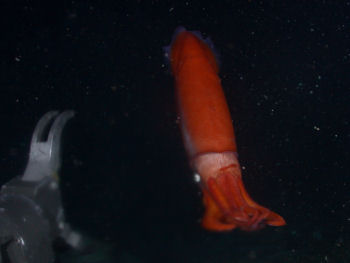Biology
Forget the rainforests, or the African savannah that you see on television wildlife programmes - the deep sea is the largest habitat for life on Earth. More than half our planet is covered by water more than 3000 metres deep, and life exists at all depths in the oceans, down to the bottom of the deepest trenches. But this vast habitat is also the one about which we know the least.

Marine biologists used to think that deep-sea life was always slow and scarce, until the discovery of volcanic vents on the ocean floor in the late 1970s. Scattered along a chain of undersea volcanoes 40 000 miles long, known as the mid-ocean ridge, these vents spew out hot, mineral-laden water that supports lush colonies of deep-sea creatures.
Investigations of these 'islands' of life on the ocean floor over the past three decades have found hundreds of new animal species, revolutionised ideas about how ecosystems can be supplied with energy, and even provided clues to the origins of life. But vast areas of the deep sea remain unexplored, although we know there are many more deep-sea vents out there, and yet more new species awaiting discovery.
Back in the nineteenth century, naturalists could literally trip over new species when they set foot on previously-unexplored terrestrial islands. We are enjoying a similar age of discovery in the deep sea today, as we explore these 'islands' of life on the ocean floor. When you come across an animal at more than 3000 metres deep, there is a 50-50 chance that it will be a new species. And just as the historic exploration of terrestrial islands taught us about patterns of life on land, the exploration of deep-sea vents is revealing the web of life in the deep ocean.
So far we have found six 'provinces' of animal life at vents, where different species are found at vents in different regions. These provinces are akin to terrestrial continents - for example, you find lions living in Africa, and tigers in India. Unlike those patterns of life on land, we have little idea what creates such patterns beneath the waves. But the Cayman Trough may hold the key to understanding them.
Page 1: Life at deep-sea vents
Page 2: Why should anyone care about patterns of life in the oceans?
Page 3: Why are we investigating the Cayman Trough in particular?
Want to dive deeper?
Read more about life at vents in Citizens of the deep
Visit Venture Ocean to find out more about vent biology
Explore the biogeography of vents in an article by Cindy Van Dover
Read more on vent ecology in a feature from the British Ecological Society Bulletin
Visit Deep Sea News for a blog post about the life-cycles of vent animals
Download a news feature about recent vent discoveries from the journal Nature
(personal or institutional subscription required)
Download a review paper about vent biogeography from the journal Science
(personal or institutional subscription required)
Science
Find out more about the Cayman Trough, undersea volcanoes, deep-sea vents,
and the inhabitants of the abyss.
What are we investigating?


